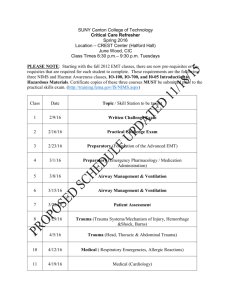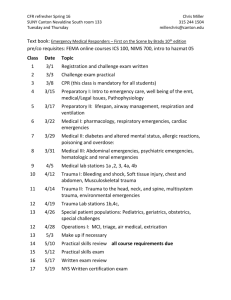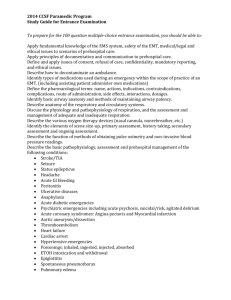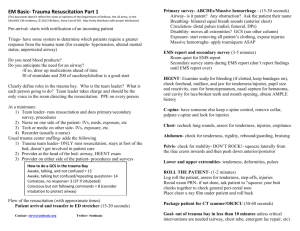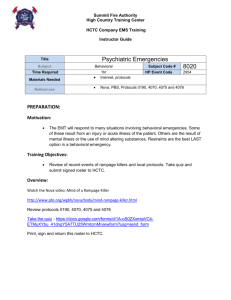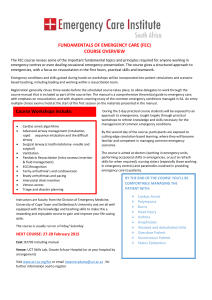QUEENSBOROUGH COMMUNITY COLLEGE
advertisement
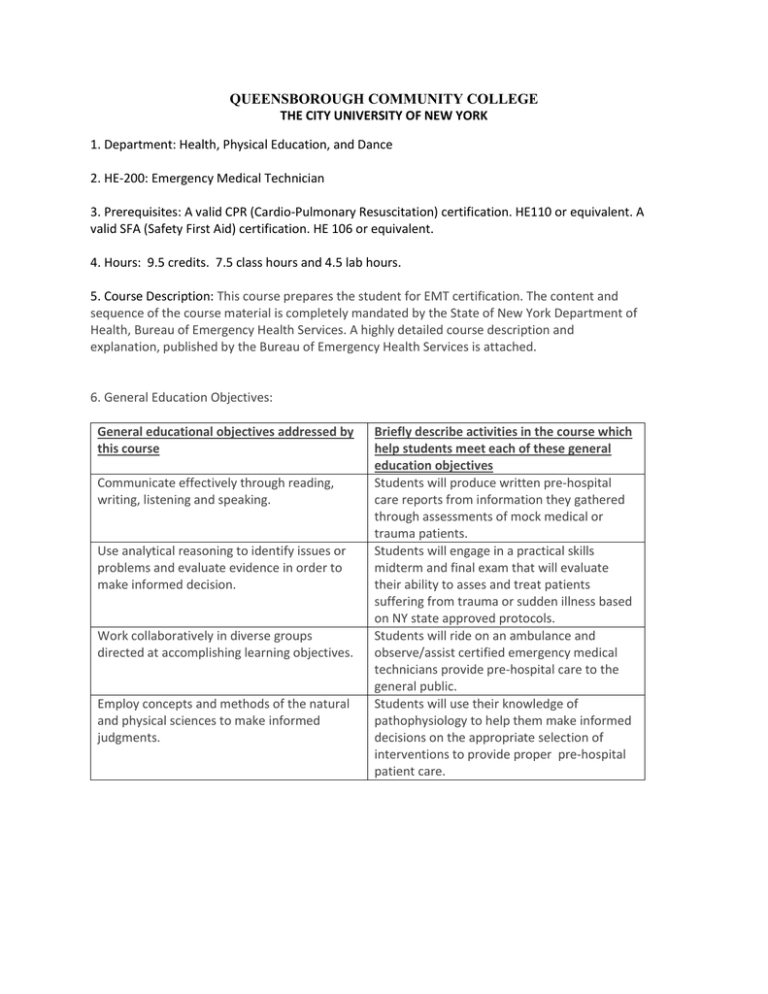
QUEENSBOROUGH COMMUNITY COLLEGE THE CITY UNIVERSITY OF NEW YORK 1. Department: Health, Physical Education, and Dance 2. HE-200: Emergency Medical Technician 3. Prerequisites: A valid CPR (Cardio-Pulmonary Resuscitation) certification. HE110 or equivalent. A valid SFA (Safety First Aid) certification. HE 106 or equivalent. 4. Hours: 9.5 credits. 7.5 class hours and 4.5 lab hours. 5. Course Description: This course prepares the student for EMT certification. The content and sequence of the course material is completely mandated by the State of New York Department of Health, Bureau of Emergency Health Services. A highly detailed course description and explanation, published by the Bureau of Emergency Health Services is attached. 6. General Education Objectives: General educational objectives addressed by this course Communicate effectively through reading, writing, listening and speaking. Use analytical reasoning to identify issues or problems and evaluate evidence in order to make informed decision. Work collaboratively in diverse groups directed at accomplishing learning objectives. Employ concepts and methods of the natural and physical sciences to make informed judgments. Briefly describe activities in the course which help students meet each of these general education objectives Students will produce written pre-hospital care reports from information they gathered through assessments of mock medical or trauma patients. Students will engage in a practical skills midterm and final exam that will evaluate their ability to asses and treat patients suffering from trauma or sudden illness based on NY state approved protocols. Students will ride on an ambulance and observe/assist certified emergency medical technicians provide pre-hospital care to the general public. Students will use their knowledge of pathophysiology to help them make informed decisions on the appropriate selection of interventions to provide proper pre-hospital patient care. 7. Course Objectives: Students will Apply fundamental knowledge of the EMS system, safety/well-being of the EMT, medical/legal and ethical issues to the provision of emergency care Students will understand the importance of EMS systems, the roles and responsibilities of EMS personnel, and the importance of patient safety Students will recognize the importance of research in emergency medical care and utilize evidence based practice in decision making when appropriate. Students will use the principles of communicating to achieve a positive relationship with patients. Students will be able to adjust communication strategies for age, stage of development, patients with special needs, and differing cultures. Students will describe medical, legal, and ethical issues as they apply to the emergency medical technician. Students will apply knowledge of anatomy and physiology function of all human systems to the practice of EMS. Students will use medical terminology in written and oral communication with colleagues and other health care professionals. Students will apply knowledge of pathophysiology of respiration and perfusion to patient assessment and management. Students will apply knowledge of lifespan development to patient assessment and management. Students will apply principles of illness and injury prevention in emergency care. Students will apply knowledge of medications that an EMT may assist or administer to a patient during an emergency. Including names, actions, indications, contraindications, complications, routes of administration, side effects, interactions, and dosages for the medications administered Students will apply their knowledge of general anatomy and physiology to patient assessment and management in order to assure patient airway, adequate mechanical ventilation, and respiration for patients of all ages. Students will apply scene information and patient assessment findings (scene size up, primary and secondary assessment, patient history, and reassessment) to guide emergency management. Students will provide basic emergency care and transportation based on assessment findings for an acutely ill patient. Including neurology, abdominal and gastrointestinal disorders, immunology, infectious diseases, endocrine disorders, psychiatric emergencies, cardio vascular emergencies, toxicology, respiratory emergencies, hematology, genitourinary disorders, gynecology, non-traumatic musculoskeletal disorders, and diseases of the ear nose and throat. Students will apply knowledge of the causes, pathophysiology, and management of shock, respiratory failure or arrest, cardiac failure or arrest, and post resuscitation management. Students will provide basic emergency care and transportation based on assessment findings for an acutely injured patient. Including bleeding, chest trauma, abdominal and genitourinary trauma, orthopedic trauma, soft tissue trauma, head trauma, facial trauma, neck trauma, and spinal trauma, nervous system trauma, environmental emergencies, and multi system traumas. Students will apply their knowledge of growth, development, and aging and assessment findings to provide basic emergency care and transportation for a patient with special needs. Including obstetrics, neonatal care, pediatrics, and geriatrics. Students will demonstrate competency in operational roles and responsibilities to ensure safe patient, public, and personnel safety. Students will perform a basic history and physical examination to identify acute complaints and monitor changes. Students will communicate clearly in a culturally sensitive manner. Students will demonstrate professional behavior including: but not limited to, integrity, empathy, self-motivation, appearance/personal hygiene, self-confidence, communications, time management, teamwork/ diplomacy, respect, patient advocacy, and careful delivery of service. Students will initiate basic interventions based on assessment findings intended to mitigate the emergency and provide limited symptom relief while providing access to definitive care. Student Learning Outcomes Students will Apply fundamental knowledge of the EMS system, safety/well-being of the EMT, medical/legal and ethical issues to the provision of emergency care A. Students will describe the importance of EMS systems, the roles and responsibilities of EMS personnel, and the importance of patient safety B. Students will describe the importance of research in emergency medical care and utilize evidence based practice in decision making when appropriate. Students will use the principles of communicating to achieve a positive relationship with patients. Students will be able to adjust communication strategies for age, stage of development, patients with special needs, and differing cultures. A. Students will define and describe verbal defusing strategies. B. Students will identify family presence issues. C. Students will describe different interviewing techniques. Students will describe medical, legal, and ethical issues as they apply to the emergency medical technician. A. Students will define and describe consent, refusal of care, confidentiality, advanced directives, tort and criminal actions, evidence preservation, and statutory responsibilities. Students will apply knowledge of anatomy and physiology function of all human systems to A. Students will describe the function and structure of the cardiovascular the practice of EMS. system. B. Students will describe and define the function and structure of the respiratory system. Students will apply knowledge of medications that an EMT may assist or administer to a patient during an emergency. Including names, actions, indications, contraindications, complications, routes of administration, side effects, interactions, and dosages for the medications administered A. Students will describe and define medication safety. B. Students will identify kinds of medications used in an emergency. C. Students will describe and demonstrate how to assist or administer medications in an emergency. Students will apply their knowledge of general anatomy and physiology to patient assessment and management in order to assure patient airway, adequate mechanical ventilation, and respiration for patients of all ages. A. Students will describe and demonstrate an airway assessment. Students will apply scene information and patient assessment findings (scene size up, primary and secondary assessment, patient history, and reassessment) to guide emergency management. A. Students will demonstrate a comprehensive primary and secondary assessment B. Students will demonstrate a comprehensive patient interview. Students will provide basic emergency care and transportation based on assessment findings for an acutely ill patient. Including neurology, abdominal and gastrointestinal disorders, immunology, infectious diseases, endocrine disorders, psychiatric emergencies, cardio vascular emergencies, toxicology, respiratory emergencies, hematology, genitourinary disorders, gynecology, non-traumatic musculoskeletal disorders, and diseases of the ear nose and throat. Students will apply knowledge of the causes, pathophysiology, and management of shock, respiratory failure or arrest, cardiac failure or arrest, and post resuscitation management. A. Students will use information gathered from knowledge of pathophysiology, their patient assessment to describe the management of several different types of medical emergencies. B. Students will describe factors that may affect destination decisions. Students will apply their knowledge of growth, development, and aging and assessment findings to provide basic emergency care and transportation for a patient with special needs. Including obstetrics, neonatal care, A. Students will use information gathered from knowledge of pathophysiology, their patient assessment to describe the management of several different types B. Students will describe techniques of assuring a patent airway. A. Students will demonstrate proficiency in resuscitation techniques like CPR. B. Students will describe post resuscitation management. pediatrics, and geriatrics. of traumatic emergencies. B. Students will define and describe trauma scoring. C. Students will identify rapid transport and destination issues. 8. Topics covered: EMS systems, research, workforce safety and wellness, documentation, therapeutic communication, medical/legal issues, ethics, anatomy and physiology, pathophysiology, lifespan development, public health, pharmacology, airway management, oxygen administration, patient assessment, neurology, abdominal and gastrointestinal disorders, immunology, infectious diseases, endocrinology, psychiatric emergencies, toxicology, hematology, non-traumatic musculoskeletal disorders, shock and resuscitation, traumatic injuries, vehicle extrication, hazardous material awareness, mass casualty incidents, and terrorism. 9: Required Reading: Emergency Care Plus MyBradyLab with Pearson eText Publication Date: July 21, 2012 | ISBN-10: 0133251942 | ISBN-13: 978-0133251944 | Edition: 12 New York State Department of Health Statewide Basic Life Support Adult and Pediatric Treatment Protocols EMT-B and AEMT Publication Date 11/20/08 BLS for the Healthcare Provider (Student Manual) Publication Date: March 1, 2011 | ISBN10: 1616690399 | ISBN-13: 978-1616690397 | Edition: 1 10. Required Equipment: Blood Pressure Cuff, Penlight, Stethoscope, and a Watch with seconds hand indicator. 11: Methods of Evaluation: Students will be evaluated by attendance, quizzes, seven written examinations, practical skills examinations, and a final written and practical examination. 12. Recommended Attire: This class is very practical in nature and requires physical work so students should dress in appropriate comfortable clothing during laboratory skills sessions. When on clinical rotations students must wear a white button down or polo shirt, blue or black slacks, and black shoes or boots. 13. Academic Integrity Policy: According to the College’s Academic Integrity policy, you must avoid plagiarism, fabrication, cheating, and all forms of academic misconduct. For more information, consult the College Catalog, as well as this document: http://web.cuny.edu/academics/infocentral/policies/academic-integrity.pdf Typical consequences for some Academic Integrity violations: •First offense: A grade of 0% on the assignment. This grade cannot be dropped. •Second offense: An F in the class and the filing of a report with the Office of Student Affairs. 14. Accommodations for Disabilities: Any student who feels that he/she may need an accommodation based upon the impact of a disability should contact me privately to discuss your specific needs. Please contact the office of Services for Students with Disabilities in Science Building, room 132 (718-631-6257) to coordinate reasonable accommodations for documented disabilities.
